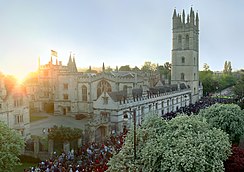Magdalen College, Oxford
![]()
This article is about Magdalen College in Oxford. For the similarly pronounced Magdalene College in Cambridge, see Magdalene College.
Magdalen College [ˈmɔːdlɪn] is one of the older colleges of Oxford University. Founded in 1458, Magdalen is still considered one of the most prestigious and beautiful colleges in the university. Magdalen College is located on the eastern edge of Oxford city centre, on the banks of the River Cherwell.
Bishop Waynflete founded Magdalen College on the site of St John's Hospital in 1458; the new buildings were erected from 1474 (when the foundation stone was laid) by the Oxford builder William Orchard. The remains of the old hospice were incorporated in the process. Famous features include Magdalen's 15th-century central cloisters (Cloisters), the parklands (especially Addison's Walk), the 44-metre-high bell tower and the 19th-century New Building.
Every year on 1 May at 6am the Latin chant of the Magdalen College Choir resounds from the top of the tower. From 1543 to 1548, the English composer John Sheppard was the college's director of music. The title informator choristarum is still given to the music director today.
A contemporary copy of Leonardo da Vinci's "Last Supper" has been in the college's chapel since the early 1990s.
One of Magdalen College's most famous graduates was the Irish-born writer Oscar Wilde. In the 1950s, C. S. Lewis taught here; known, among other things, as the author of the Narnia novels. The historian A. J. P. Taylor was associated with Magdalen, as was the Nobel Prize winner for literature, Seamus Heaney. Lord Denning, the most distinguished British judge of the 20th century, as well as David Souter and Stephen Breyer, both U.S. Supreme Court justices, also studied at Magdalen College. Another well-known student was the historian Edward Gibbon.

Magdalen College
Search within the encyclopedia